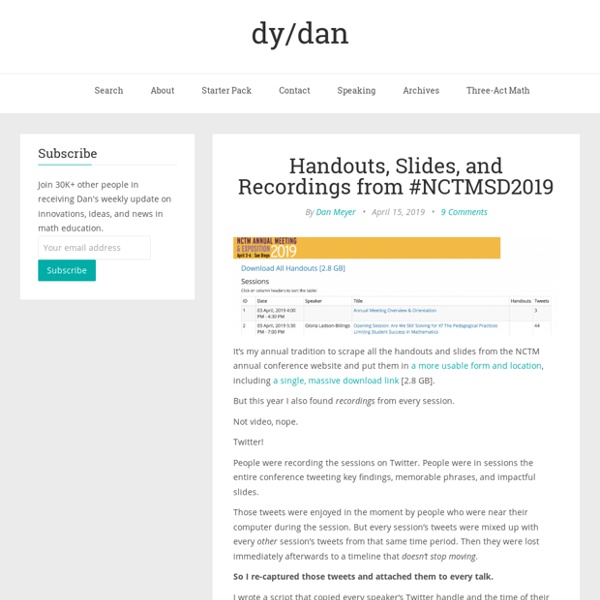New Zealand maths curriculum
IXL's maths skills are aligned to the New Zealand National Standards and the New Zealand Curriculum, providing comprehensive coverage of maths concepts and applications. With IXL's national curriculum alignments, you can easily find unlimited practice problems specifically tailored to each learning objective. IXL members receive exclusive access to IXL's national curriculum reports. These comprehensive reports cover everything you need to know about your students' progress, including: A breakdown of the IXL skills that comprise each objective, and how your students are progressing on each.
3 Act Math – When Math Happens
The 3 Act Math format was developed by Dan Meyer. See the links below. Explanation Post Modeled Lesson Dan’s Lessons 5 Practices All 3rd 4th 5th 6th 7th 8th Alg 1 Geom Alg 2 Stat Calc Calculator Countdown How many times?
Virtual Field Trips
Home Browse: By Categories All Administrator ResourcesAssessment & Review Blended LearningBloggingBundles & ToolkitsBusiness EducationClassroom ManagementCollege & Career ReadinessCommon CoreCommunication & CollaborationDesktop ApplicationsDifferentiated LearningDigital CitizenshipDigital MediaDigital StorytellingESL/ELLGoogleInteractive WhiteboardsInternet SearchesiPads & Mobile LearningLearning Theories & StrategiesMembershipsNETS-TOrganizational & Time-saving ToolsPersonal EnrichmentPodcastingReading & WritingResponse to Intervention (RTI)School SafetySocial MediaSpecial Education STEMTech Integration BasicsTools for Student ProjectsVirtual LearningWeb Tool OverviewsWebsite CreationWikisWorkplace more... Favorites
math. macs. teaching. - Algebra II Resources
To start, you may be interested in my current theories on Algebra II. Pivot Algebra II Part One, Part Two, Part Three Some of this work is original. Some is adapted from countless other people and resources. It is presented here as a jumping off point towards refining your own style.
Creating Classrooms We Need: 8 Ways Into Inquiry Learning
If kids can access information from sources other than school, and if school is no longer the only place where information lives, what, then happens to the role of this institution? “Our whole reason for showing up for school has changed, but infrastructure has stayed behind,” said Diana Laufenberg, who taught history at the progressive public school Science Leadership Academy for many years. Laufenberg provided some insight into how she guided students to find their own learning paths at school, and enumerated some of these ideas at SXSWEdu last week.
A School Built Entirely Around the Love of Math
Getty Prodigies in piano or dance can study at schools like Juilliard to develop their musical or performing arts talent. By contrast, nothing like Juilliard exists for children who show great promise at math.
Fluency Without Fear
Download PDF By Jo Boaler, Professor of Mathematics Education, co-founder youcubed With the help of Cathy Williams, co-founder youcubed & Amanda Confer, Stanford University Updated January 28th, 2015 Introduction A few years ago a British politician, Stephen Byers, made a harmless error in an interview.
ODE Extended Standards
The Ohio Academic Content Standards – Extended (OACS-E) also are commonly known as "the extended standards." These standards help to ensure that students with significant cognitive disabilities are provided with multiple ways to learn and demonstrate knowledge. At the same time, the extended standards are designed to maintain the rigor and high expectations of Ohio’s Learning Standards. The Offices for Curriculum, Assessment and Exceptional Children have worked collaboratively since July 2011 in the creation of extensions to Ohio’s Learning Standards for English Language Arts and Math as well as the revised standards for Science and Social Studies. A committee comprised of special educators, regular educators, parents, administrators and other stakeholders in Ohio came together in the writing of these extensions to be used for students participating in the Alternate Assessment. Each subject area has its own link below.
Real-world math problems are everywhere
Share We hear this everywhere – students should be doing “real-world” math and they should be applying what they learn in math to “real-world situations.” Textbooks and math resources advertise their “real-world problem solving” experiences and “real-life math applications.” But, as those of us who are math teachers can attest, often times the real-world examples are contrived or forced and—let’s face it—not very interesting to students. I mean, what student really cares what time two trains leaving from New York and Detroit are going to cross paths?
Web App Reviews: Geogebra
Watch our video review: As a previous math teacher, I believe math can and should be fun. One way to make math fun is to make it hands-on, interactive, and inquiry based. Then instead of simply telling students a formula or rule, the students can discover it themselves, and really understand and own the ideas. A great tool to help teachers accomplish this is GeoGebra, a free online web app for interactive geometry. With GeoGebra students can work with points, lines, angles, polygons, equations, reflections, transformations, statistics, and more.
In Teaching Algebra, the Not-So-Secret Way to Students’ Hearts
Teaching Strategies Ed Yourdon/Flickr Education researchers are beginning to validate what many teachers have long known — connecting learning to student interests helps the information stick. This seems to work particularly well with math, a subject many students say they dislike because they can’t see its relevance to their lives.



